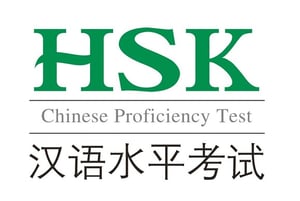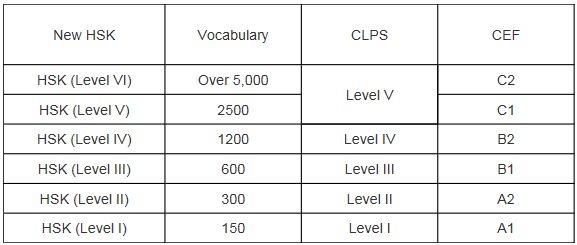A Reminder: What is the HSK test?
HSK (Hanyu Shuiping Kaoshi, translated as the Chinese Proficiency Test) is the most popular standard Chinese language exam for foreigners and overseas Chinese. It is well-known all over the world and uses simplified characters.
The HSK includes two independent tests: one focuses on writing, reading and listening, while the other, called HSKK, only focuses on speaking. There are six levels of writing tests, starting from HSK Level 1 to HSK Level 6, and three levels of speaking tests for HSKK (beginner, intermediate and advanced). Test takers' speeches are recorded during the speaking test.
Regarding the HSK test, you are rated on 200 points for level 1 and 2, and on 300 points for level 3 to 6. A certificate is awarded if you reach an average of 120/200 or 180/300. The HSK exam is quite short compared to other language exams. It lasts between 35 minutes (level 1) and 2h15 minutes (level 6). Many exercises are approximately the same from one level to another (similar instructions). However, progressing to HSK level 6, the sentences become longer, the grammar becomes more complex and the vocabulary is expanded.

The difference between each level is presented like this:

[Source of the image]
Most of the Chinese universities ask students coming to China to pass the test when studying a degree (usually asking for HSK level 4 or 5). Some Chinese companies may also require an HSK certificate when hiring a foreign talent (mostly requiring level 5 or 6). Most importantly, the HSK certification is taken into account when applying for a Chinese working visa, and it also helps foreign students to get a scholarship from the Chinese government.
What does HSK level 3 exactly consist of?
The written HSK test consists of three parts: a listening section, a reading section and a writing section. Each part is worth 100 points, even though they differ in duration and (in my opinion) difficulty.
Listening Part
During the listening part, the participant needs to listen to short dialogues or statements and answer questions about them. Each dialogue is played twice and there is one question per dialogue.
This part is 35 minutes long, followed by 5 minutes to transfer your answer from the draft paper to the official answer paper. If you have practiced a lot of listening, you will often get the answer after the first time you hear the dialogue, so you can use the second time to confirm your initial idea.
Tips: It is a very good idea to have a brief glance at the provided answer options before the next dialogue plays, so you know what sort of information to listen for. Many dialogues have a male and a female voice and the question is then about what either the man or the woman said, so you should try to remember more or less what each person said (not the exact words but their intent). The dialogues vary in length between 2 and 4 turns.
Reading Part
The reading part has three types of tasks. The first one consists of matching sentences together. The second one consists of filling blanks of different sentences with different words. The last one is a multiple-choice question exercise.
This part of the exam is 30 minutes long; 10 minutes for each task. You don't need to write Chinese characters of this part of the exam but you need to be able to read them fluently.
Tips: Don’t try to spend too much time on things you can’t answer. Focus more on what you can answer. If at the end you have some time left, then use it to review the part that were the most complicated for you.

Writing Part
The writing part has two types of tasks. First, there are the five sentence building task: you are given 3 to 6 items that you need to put in the correct order to build a sentence. The "items" may be individual characters, words or phrases. Second, five sentences where one character has been replaced by its pinyin transcription (with tone marks); you need to write the correct character.
This is the only part of the exam that requires you to write characters (if it is computer-based, be sure you know how to type Chinese on a computer).
Even though it consists of very few items, you get ten minutes for this part of the exam (five minutes for each part). If you are thoroughly familiar with the characters from the lists published by Hanban, the second part is very easy. The first part also requires basic knowledge of syntax
Tips: Make sure to practice your grammar skills using teaching material workbooks. Understanding Chinese basic grammar rules will help you succeed in the “building sentences” exercises.
Which kind of study materials will you need to prepare for the HSK test level 3?
First, try to take a mock test online in order to see what level fits you the most. If the level 3 is the level that suits you the most, then it is time for you to prepare the test.
You can try different mock tests here for every level of HSK. Also, there are some amazing books that can be found for all the different levels. For example, this one, attached with a CD-ROM, covers 10 mock tests with a CD-ROM so that you can practice all three parts of the test: listening, reading and writing. This edition exists for all 6 levels and allows you to practice on real HSK templates. In regards to writing, try to ask a Chinese friend or a Chinese teacher to correct your work.
Regarding the vocabulary, you should learn contextual sentences and not just the words. This amazing Youtube video here lists all of the words you need to master and also provides different examples for each word, which allows you to learn the words and most importantly, get to know how to use them correctly.
Tips: make as many mock test as you can. Try to get familiar with the structure and logic of the exam. For the listening part, listen to the audio several time when you don’t get it, and refer to audio scripts to catch up the words you couldn’t understand at first.
For the reading part, right down every mistake you have made and list the vocabulary you haven’t studied yet that appeared in the mock test. A good knowledge of the HSK 3 vocabulary list (600 words) is a good advantage in succeeding.
Finally, for the writing part, make sure to master the basic point of the Chinese grammar. You can find a lot of grammar exercises online that can help you with this part. Once again, if you have made sure to know your vocabulary, you can be sure to get a high grade for this part.
Practice makes perfect

The HSK exam tests your listening, reading, and writing skills. As a famous Chinese idiom says: “熟能生巧” (shúnéngshēngqiǎo), which means “practice makes perfect”. So don’t hesitate to do a lot of mock exams, whether online or with specific books that prepare you for the test.
And if you want to have a real Chinese class experience with professionals, you can also take online Chinese classes on TutorABC Chinese. TutorABC Chinese’s teachers, referred as consultants, are all certified with years of teaching experience, and undergo extensive training, so they can guide you through a complete learning process that will help you to achieve your goal by getting a high result on the HSK test.
